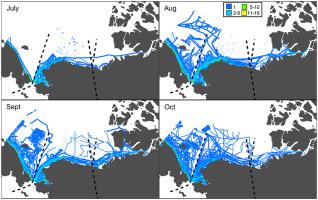当前位置:
X-MOL 学术
›
Ocean Coast Manage.
›
论文详情
Our official English website, www.x-mol.net, welcomes your
feedback! (Note: you will need to create a separate account there.)
Potential exposure of beluga and bowhead whales to underwater noise from ship traffic in the Beaufort and Chukchi Seas
Ocean & Coastal Management ( IF 4.8 ) Pub Date : 2020-11-01 , DOI: 10.1016/j.ocecoaman.2020.105473 William D. Halliday , Matthew K. Pine , John J. Citta , Lois Harwood , Donna D.W. Hauser , R. Casey Hilliard , Ellen V. Lea , Lisa L. Loseto , Lori Quakenbush , Stephen J. Insley
Ocean & Coastal Management ( IF 4.8 ) Pub Date : 2020-11-01 , DOI: 10.1016/j.ocecoaman.2020.105473 William D. Halliday , Matthew K. Pine , John J. Citta , Lois Harwood , Donna D.W. Hauser , R. Casey Hilliard , Ellen V. Lea , Lisa L. Loseto , Lori Quakenbush , Stephen J. Insley

|
Abstract Sea ice loss associated with a changing climate is resulting in increased levels of ship traffic in the Arctic, which in turn is causing increased underwater noise levels and associated impacts on marine life. Estimating the possible, present levels of exposure of marine life to underwater noise is a crucial step in understanding and managing contemporary exposures and underwater noise levels, and will inform future planning actions and mitigation. In this study, we examined the overlap between modeled underwater noise from ship traffic from 2015 to 2017 and monthly utilization distributions of beluga (Delphinapterus leucas) and bowhead whales (Balaena mysticetus) calculated from satellite telemetry data collected between 1995 and 2018 in the Beaufort and Chukchi seas. We first modeled noise propagation from observed vessel traffic in the Pacific Arctic from Amundsen Gulf in the east to Bering Strait in the west. We modeled the propagation loss of underwater noise from different classes of vessels that were transiting the area, and then applied these values to actual ship tracks (derived from satellite automatic identification system data) to model monthly noise footprints between July and October in each year between 2015 and 2017. We overlaid the monthly noise footprints with monthly 50% utilization distributions for satellite-tagged eastern Beaufort Sea beluga whales (1993–1997, 2004–2006) and Bering-Chukchi-Beaufort bowhead whales (2006–2018). Vessel traffic and its associated underwater noise were highest in all months in the southern Chukchi Sea near Bering Strait, particularly along the Russian and Alaskan coastlines. In comparison, traffic was lower in the western Canadian Arctic and in offshore areas; within the western Canadian Arctic, traffic was higher in August and September than in July and October. In July, low ship traffic resulted in low levels of overlap between modeled underwater noise and the utilization distributions for both whale species because the whales tend to use habitats in the eastern Beaufort Sea and Amundsen Gulf. Conversely, in August through September, there was medium to high overlap between underwater noise and the distributions for both species as ship traffic increased in those months and the distribution of both species began shifting towards the Chukchi Sea. Both beluga and bowhead whales migrate through areas with the highest levels of traffic in the Pacific Arctic, and are potentially exposed to a high number of acoustic disturbance events in three national jurisdictions. Without proactive vessel management and effective mitigation measures, acoustic disturbance of whales is expected to increase, and eventually expand to more months of the year, as ship traffic continues to increase in step with increases in the length of the open water season.
中文翻译:

白鲸和弓头鲸可能暴露在波弗特海和楚科奇海船舶交通产生的水下噪音中
摘要 与气候变化相关的海冰损失导致北极船舶交通量增加,进而导致水下噪音水平增加并对海洋生物产生相关影响。估计海洋生物目前可能的水下噪声暴露水平是理解和管理当代暴露和水下噪声水平的关键步骤,并将为未来的规划行动和缓解提供信息。在这项研究中,我们检查了 2015 年至 2017 年船舶交通的模拟水下噪声与白鲸 (Delphinapterus leucas) 和弓头鲸 (Balaena mysticetus) 的月度利用分布之间的重叠,该分布是根据 1995 年至 2018 年在博福特和 2018 年收集的卫星遥测数据计算得出的。楚科奇海。我们首先模拟了从东部的阿蒙森湾到西部的白令海峡的太平洋北极地区观察到的船只交通的噪声传播。我们对经过该地区的不同类别船舶的水下噪声传播损失进行建模,然后将这些值应用于实际船舶轨迹(来自卫星自动识别系统数据),以模拟每年 7 月和 10 月之间的每月噪声足迹2015 年和 2017 年。我们用卫星标记的东波弗特海白鲸(1993-1997、2004-2006)和白令-楚科奇-波弗特弓头鲸(2006-2018)的每月 50% 的利用率分布覆盖了每月的噪声足迹。在靠近白令海峡的楚科奇海南部,船只交通及其相关的水下噪音在所有月份中最高,特别是在俄罗斯和阿拉斯加海岸线。相比之下,加拿大西部北极地区和近海地区的交通量较低;在加拿大西部北极地区,8 月和 9 月的交通量高于 7 月和 10 月。7 月,由于鲸鱼倾向于使用波弗特海东部和阿蒙森湾的栖息地,因此船舶交通量低导致模拟的水下噪声与两种鲸鱼物种的利用分布之间的重叠程度较低。相反,在 8 月至 9 月,随着这几个月船舶交通量的增加,水下噪声与这两种物种的分布之间存在中度到高度的重叠,并且这两种物种的分布开始向楚科奇海转移。白鲸和弓头鲸都迁徙到太平洋北极地区交通量最高的地区,并且可能在三个国家管辖范围内遭受大量声干扰事件。如果没有积极的船舶管理和有效的缓解措施,随着船舶交通量随着开放水域季节长度的增加而继续增加,预计鲸鱼的声音干扰会增加,并最终扩大到一年中的更多月份。
更新日期:2020-11-01
中文翻译:

白鲸和弓头鲸可能暴露在波弗特海和楚科奇海船舶交通产生的水下噪音中
摘要 与气候变化相关的海冰损失导致北极船舶交通量增加,进而导致水下噪音水平增加并对海洋生物产生相关影响。估计海洋生物目前可能的水下噪声暴露水平是理解和管理当代暴露和水下噪声水平的关键步骤,并将为未来的规划行动和缓解提供信息。在这项研究中,我们检查了 2015 年至 2017 年船舶交通的模拟水下噪声与白鲸 (Delphinapterus leucas) 和弓头鲸 (Balaena mysticetus) 的月度利用分布之间的重叠,该分布是根据 1995 年至 2018 年在博福特和 2018 年收集的卫星遥测数据计算得出的。楚科奇海。我们首先模拟了从东部的阿蒙森湾到西部的白令海峡的太平洋北极地区观察到的船只交通的噪声传播。我们对经过该地区的不同类别船舶的水下噪声传播损失进行建模,然后将这些值应用于实际船舶轨迹(来自卫星自动识别系统数据),以模拟每年 7 月和 10 月之间的每月噪声足迹2015 年和 2017 年。我们用卫星标记的东波弗特海白鲸(1993-1997、2004-2006)和白令-楚科奇-波弗特弓头鲸(2006-2018)的每月 50% 的利用率分布覆盖了每月的噪声足迹。在靠近白令海峡的楚科奇海南部,船只交通及其相关的水下噪音在所有月份中最高,特别是在俄罗斯和阿拉斯加海岸线。相比之下,加拿大西部北极地区和近海地区的交通量较低;在加拿大西部北极地区,8 月和 9 月的交通量高于 7 月和 10 月。7 月,由于鲸鱼倾向于使用波弗特海东部和阿蒙森湾的栖息地,因此船舶交通量低导致模拟的水下噪声与两种鲸鱼物种的利用分布之间的重叠程度较低。相反,在 8 月至 9 月,随着这几个月船舶交通量的增加,水下噪声与这两种物种的分布之间存在中度到高度的重叠,并且这两种物种的分布开始向楚科奇海转移。白鲸和弓头鲸都迁徙到太平洋北极地区交通量最高的地区,并且可能在三个国家管辖范围内遭受大量声干扰事件。如果没有积极的船舶管理和有效的缓解措施,随着船舶交通量随着开放水域季节长度的增加而继续增加,预计鲸鱼的声音干扰会增加,并最终扩大到一年中的更多月份。











































 京公网安备 11010802027423号
京公网安备 11010802027423号